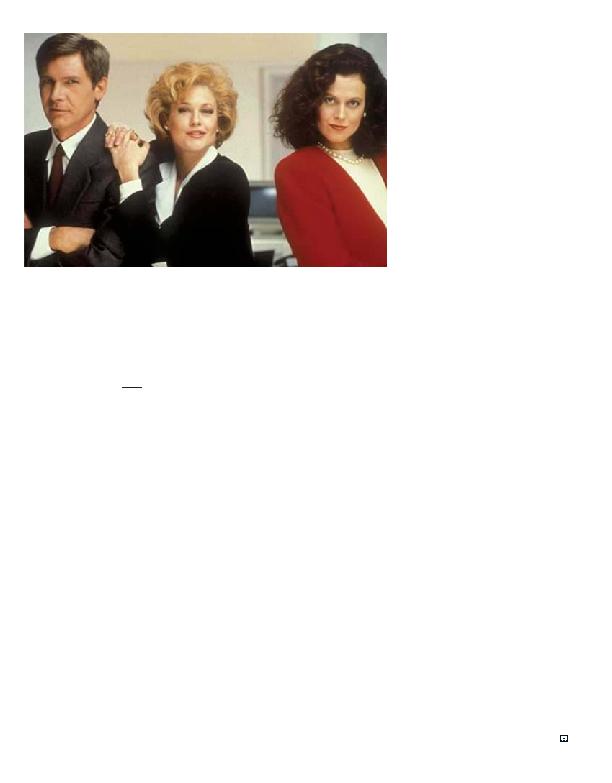
Elegant.... Oversized leather
furniture, oversized potted
palms, an oversized oil
portrait of Katharine hanging
over the mantle. Tess tours,
gingerly touching fabric,
marble, wood, inspecting
books, the bar stock, etc.
Someone actually
the person Tess wants to emulate. Like every-
thing else Katharine does or wears or has, her
home is designed to impress. This is
Katharine's shrine to herself.
Cyn (Joan Cusack), has her engagement party:
working class COUPLES, the
people Tess grew up with,
people who've been coming here
forever... A couple of couples
are dancing in a tight little
spot by the jukebox.
is a picture of connection and humanity.
or oversized anything, it's jammed with peo-
ple "huddled together" in a "tight little
spot." It feels small and restrictive, just as
clinging to this life is restricting Tess' ability
to truly define herself.
vealing layers of character and theme. Isn't
that far superior to simply saying, "a big, ex-
Katharine's apartment, her clothes and even
her diction. Because deep down, Tess sees her-
self the way Katharine and everyone else sees
her: a Staten Island girl who doesn't really be-
long in this rarified world of brokers and deal-
makers. So instead of standing up for herself
and forcing them to pay attention and listen to
her ideas, she hides behind this false persona
-- what I term a character's "identity."
-- the romantic interest in this romantic
comedy -- give Tess a gold-lettered briefcase,
which is another symbol of Tess' desire for
success. But in thematic terms, it's different
than the other things Tess wears. Katharine's
clothes signify Tess' attempt to achieve suc-
cess through pretense. But Jack gives her the
briefcase because he thinks her ideas are
solid, not because of some image she proj-
ects. He respects her talent, and the briefcase
illustrates the transition Tess is making into
her essence -- into the person she truly is.
Cyn's party. Tess' estranged boyfriend Mick
(Alec Baldwin) doesn't recognize her at first,
and to fit in more with the crowd and sur-
roundings, she stows her briefcase behind
the bar. But after Tess breaks up with Mick,
we see her on the ferry again, leaving Staten
Island behind forever. Whatever happens
now, she'll never be able to go back to the
emotionally safe but unfulfilled life she had
before.
Tess is left with no place to go. At Cyn's wed-
ding, dressed in one of those hideously puffy
bridesmaids dresses, she stands apart from
everyone else. Tess no longer belongs there
and she has nothing left to hang on to.
to a false image of how she should look and
who she should be. As we see her ride the
ferry to the Promised Land one last time,
she's wearing jeans and a sweatshirt. She's
not an image of anything -- she's just Tess.
plains how she came up with the idea for a
radio network purchase, the idea that
Katharine stole from her. Tess had combined
information from The Wall Street Journal, the
New York Post and the newsletter that her sec-
retarial investment club subscribed to. In other
words, she was integrating her Staten Island
personality (Post) with her business smarts (The
Wall Street Journal) with her job as a secretary.
And only Tess could have done that.
her clothing and appearance are as plain
and ordinary as can be because she is now
fully in her essence, with no need to project
any kind of image at all.
are essential to the story. But the power of
vivid, revealing description crosses all genres
and story concepts. Every single thing you
convey about your characters' appearance and
surroundings can help reveal or reinforce an-
other facet of who they are and who they be-
come in the course of your screenplay.
you should definitely be punished for it...
READ THIS: Your job as a writer is to evoke
emotion -- not announce it -- by revealing to
the reader ONLY what the audience will see
and hear on the screen. Never talk directly to
the reader, and don't tell her how the audi-
ence will feel watching your movie. No
"asides" to provide factual information or
character background (e.g. Jan has been a
hired assassin for the last 10 years); no telling
the reader what a character thinks or feels
(e.g. Jan is very torn about shooting the little
boy and his dog) and, most of all, no telling
the reader what an audience's reaction will be
(e.g. The audience will shed tears of joy when
Jan rescues the little boy and his dog.).